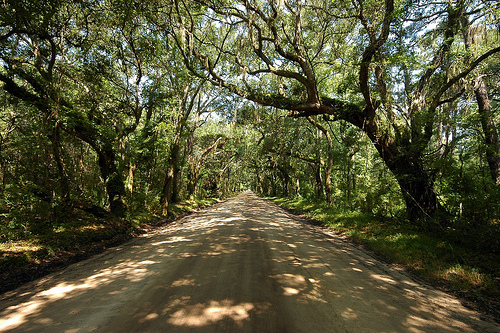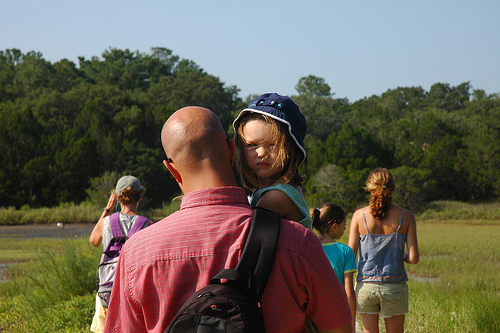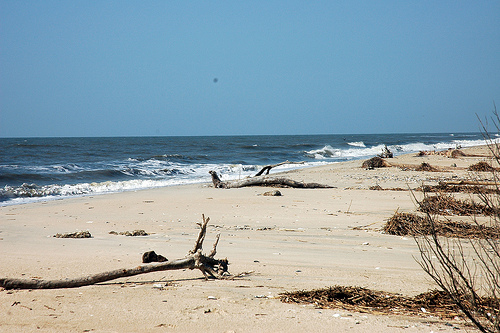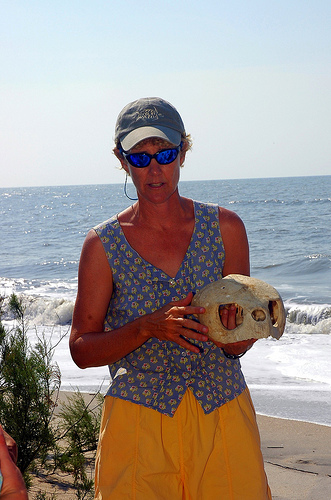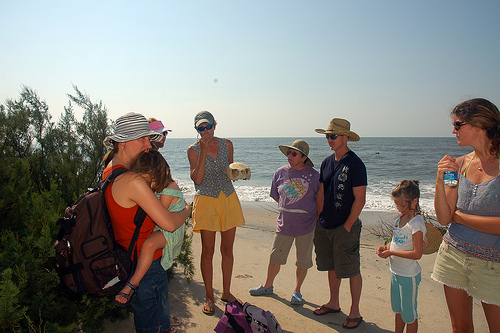Botany Bay
It’s probably one of the most famous roads on Edisto Island: a sand lane that runs under a canopy of Live Oaks, looking positively like something out of Gone With the Wind.
Botany Bay Wildlife Management area is actually made up of three plantations: Bleak Hall, Botany Bay, and Sea Cloud. All three grew sea island cotton, which has particularly long fibers and was used in France for high quality lace.
This morning, we’re going on a botany tour — appropriate, given the name of the site. One other family is joining us.
We walk among the marshes, stopping every few moments to learn a bit more about the island.
Along the way, one young lady catches a fiddler crab.
L gets her own:
We learn about the importance of the marshes as a protective barrier for hurricanes: they act as sponges and thus do much to minimize the effect of higher tides from hurricanes.
We find out that the English came to Edisto in search of riches and found a treasure in the huge Live Oaks on the island.
We learn that the use of palms in South Carolina naval fortifications were literally so effective at dissipating energy that canon balls essentially bounced off them.
We arrive at the beach, where our guide, Meg, gave us more information on loggerhead turtles and residents’ effort to help them.
It’s about the third time we’ve heard about loggerheads and the nest relocation activities of the Edistoians. They’re obviously proud of it, and rightly so: it takes a great deal of dedication among many people to keep the program going.
Meg shows us a loggerhead skull, and it’s immediately obvious how huge the turtles are. The females drag their bodies out of the water to dig a nest, and often enough, they don’t get beyond the high tide line.
The incoming tide destroys the nests; volunteers on the island, though, head out nightly and relocate the nests. Then the hatchlings only have to worry about birds and raccoons as they make their way to the surf.
After Meg leaves, we explore the beach a bit on our own, and what a beach it is — like something from a tourist brochure. In fact, it is.
The ocean is slowly reclaiming this portion of the shore. It creeps inward at a relatively steady pace, turning everything into beach, and hence killing all the flora that cannot handle an intensely salty environment.
K takes the camera and goes for a picture walk;
I stay with the Girl, hoping to talk her into the ocean,
unsuccessfully.
Ping Spong
 The Sins of Scripture: Exposing the Bible’s Texts of Hate to Reveal the God of Love is Shelby Spong’s 2005 effort to deal with several problematic themes in the Bible. Divided into sections, each section contains several chapters dealing with:
The Sins of Scripture: Exposing the Bible’s Texts of Hate to Reveal the God of Love is Shelby Spong’s 2005 effort to deal with several problematic themes in the Bible. Divided into sections, each section contains several chapters dealing with:
- The Bible and the Environment (Overpopulation and the Catholic imperative to procreate)
- The Bible and Women (Misogyny in the Bible)
- The Bible and Homosexuality
- The Bible and Children
- The Bible and Anti-Semitism
- The Bible and Certainty
- Reading Scripture as Epic History
Spong flip-flops on how to explain these problematic passages. Sometimes, he seems to say “We’ve been misinterpreting this all along”; with other passages, he seems to say, “Well, primitive times, backwards thinking.” But with certain core items, he simply disregards them as being unscientific and unable to teach us anything.
He deals with the major passages about homosexuality in the first manner. The command in Leviticus not to lie with another man as one would a woman has been misinterpreted throughout the millenia. What it means, Spong explains, is not to treat men in a subservient manner, not to treat a man like a woman. In explaining it this way, Spong is essentially saying, “This is not a homophobic text; it’s a misogynistic text!” Whew — what a relief. Apparently, the writer of Leviticus just meant “Don’t treat your lover as if he’s lower than you” or “Don’t treat him like a woman.”
The other method of dealing with troubling texts is to employ the “they didn’t know better; they were primitive people back then” argument. He does this with the misogynistic passages. He gives great detail about all the double standards in the Old and New Testament for women (women are ceremonially unclean longer when giving birth to girls; woman are not to hold positions of authority or even ask questions in church; when are to be sequestered when menstruating), and he seems simply to brush it aside by saying, “Well, we know God couldn’t be misogynistic, so these texts represent the times and culture they’re written in.”
Yet Spong occasionally dismisses whole episodes in the Bible because they simply can’t be true. For instance, the core of traditional Christianity is wrong:
Let me state this boldly and succinctly: Jesus did not die for your sins or my sins. That proclamation is theological nonsense. It only breeds more violence as we seek to justify the negativity that religious people dump on others because we can no longer carry its load. […]
We are not fallen, sinful people who deserve to be punished. We are frightened, insecure people who have achieved the enormous breakthrough into self-consciousness that marks no other creature that has yet emerged from the evolutionary cycle. (173, 4)
One reads this and thinks, “Well, what’s the point then.” The logical guess is that Spong will explain, “It’s not Jesus; it’s what he taught.” Yet many of the says of Jesus — particularly the “I am” statements in John — didn’t happen:
Of course, Jesus never literally said any of these things. For someone to wander around the Jewish state in the first century, announcing himself to be the bread of life, the resurrection or the light of the world would have brought out people in white coats with butterfly nets to take him away. (234)
There are so many problems with that that it’s difficult to know where to start. At the most basic level, this shows a profound ignorance of the nature of first century notions of mental health. We only have to look at other passages in the Bible to realize there were none. It was all attributable to demons and mystery. And there certainly wasn’t anything resembling a “funny farm,” even if we strip away the nineteenth century cliches of Spong’s metaphor. Unless Spong has some archeological evidence he’s keeping hidden, it just doesn’t have any credibility whatsoever.
If it almost seems like Spong rejects the existence of a personal God, it’s because he does.
Whoa! Spong doesn’t believe in a personal God, the kind of God that the monotheistic religions have been preaching for millenia? That’s fine — I don’t particularly believe in that God either, but what’s the point of rooting around in scripture to explain this or that when Spong doesn’t even believe in the God most theists hold to be, in one way or another, the author of that scripture?
That’s why reading this causes a certain sense of cognitive whiplash — and I’d assume it’s an experience common to most of his books. “We don’t have to throw out the Bible because of the homophobia that drips from its pages because those passages have been misunderstood for so long; but we do need to throw out the God who supposedly wrote the Bible because no one ever comes back from the dead.” Isn’t faith in that very thing the heart of Christianity?
Spong isn’t trying to revise Christianity as much as he’s attempting to create an entirely new religious system, one that puts all holy books on the same level as the Iliad or the Odyssey. I’m fine what that; that’s the level I put most holy books: instructive, but in no way more authoritative than any other book. But then to insist on calling oneself a Christian seems ridiculous.
And what’s the point of it all? No Christian who believes in the bodily resurrection of Jesus, the actual existence of Adam and Eve, and the need to be saved from Original Sin is going to say, “Hey, Shelby — good point. I’m convinced.” The only people who will be convinced are fence-riders like Spong himself, people who want the cultural comforts of belonging to a religion without any of the bothersome necessities of believing in God, Jesus, etc.
Additionally, no atheist is going to be convinced. To non-theists, Shelby seems to be taking a Trans-Am, gutting it, moving the engine to the back, and turning it into a boat and yet insisting on calling it a Trans-Am. It’s not a Trans-Am, and Spong’s creation is not Christianity.
Spong hints at what he’s after:
Creation must now be seen as an unfinished process. God cannot accurately be portrayed as resting from divine labors which are unending. There was no original perfection from which human life could fall into sin. Life has always been evolving. The Psalmist was wrong: we were not created “a little lower than the angels” (Ps. 8:5, KJV). Rather, we have evolved into a status that we judge to be only a little higher than the ape’s.
This is a very different perspective. There is a vast contrast between the definition of being fallen creatures and that of being incomplete creatures. […] We do not need some divine rescue accomplished by an invasive deity to lift us from a fall that never happened and to restore us to a status we never possessed. The idea that Jesus had to pay the price of our sinfulness is an idea that is bankrupt. When that idea collapses, so do all of those violent, controlling and guilt-producing tactics that are so deeply part of traditional Christianity.
It is like an unstoppable waterfall. Baptism, understood as the sacramental act designed to wash from the newborn baby the stain of that original fall into sin, becomes inoperative. The Eucharist, developed as a liturgical attempt to reenact the sacrifice that Jesus made on the cross that paid the price of our sinfulness, becomes empty of meaning. […]
The first step is found, I believe, in acknowledging our evolutionary origins and dispensing with any suggestion that sin, inadequacy and guilt are the definitions into which we are born. […] We might be a dead end in the evolutionary process, a creature like the dinosaur, destined for extinction. We might instead be the bridge to a brilliant future that none of us can yet imagine. (177-9)
Basically, Spong is talking more Arthur C. Clarke/2001: A Space Odyssey than anything else. Yet recall that the sequel, 2010, ends with a very Garden of Eden-esque situation:
“ALL THESE WORLDS
ARE YOURS EXCEPT
EUROPA
ATTEMPT NO
LANDING THERE
USE THEM TOGETHER
USE THEM IN PEACE”
Or maybe Spong has something else in mind. Maybe Spong doesn’t really know what he has in mind. Except that he’s a Christian, but only insofar as he reads the Bible and thinks Jesus was damn fine man (in as much as we can tell from his sayings, after we scrape away everything he obviously never said).
Spong calls himself a Christian, but it leaves me wondering what kind? It’s seems that, having been an Episcopal priest and bishop for so long, he simply can’t let go.



